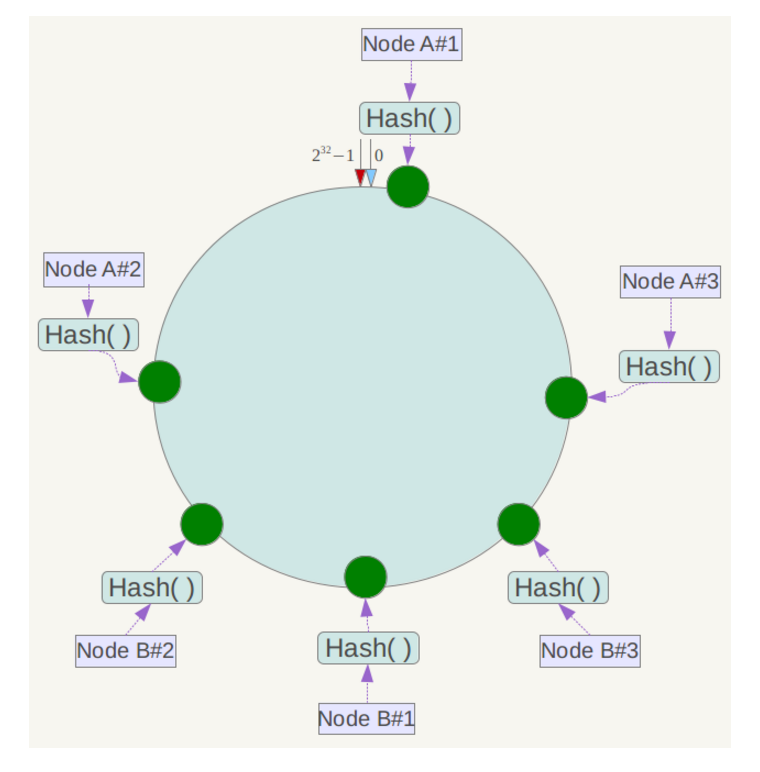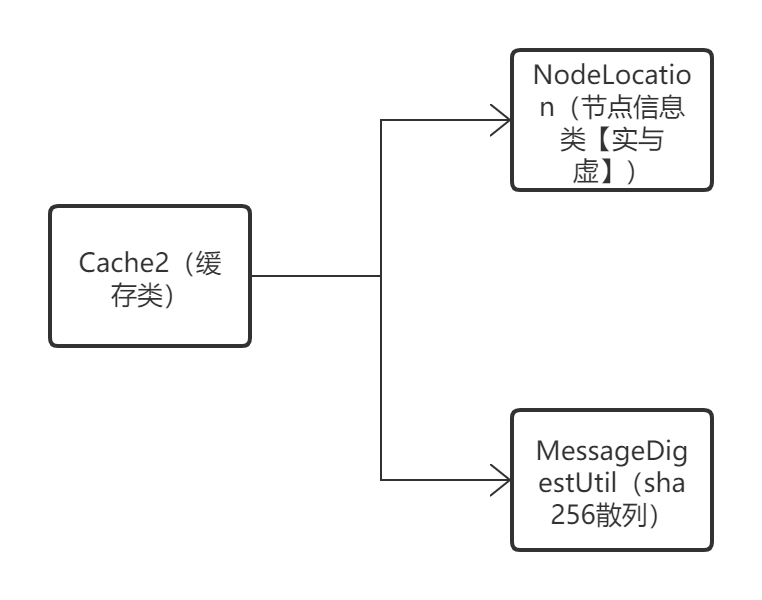架构师训练营第五周 - 作业

作业:
用你熟悉的编程语言实现一致性 hash 算法。
编写测试用例测试这个算法,测试 100 万 KV 数据,10 个服务器节点的情况下,计算这些 KV 数据在服务器上分布数量的标准差,以评估算法的存储负载不均衡性。
算法实现及插入测试数据如下:
实例化Cache对象,实例化时传入服务器列表与虚拟节点比例(如100,表示一个节点虚拟出100个)
根据虚拟化比例,对每个节点生成相应的虚拟节点,生成规则如下:在IP后加#和序号,如*#0
对所有节点(真实和虚拟)做sha256散列,生成一个字符串,求字符串hashcode值,这中间,若有相同hashcode值的,去除后来的,只保留第一个加入的。
节点及其虚拟节点对应的服务器是节点代表的服务器
因为所有节点是近乎均匀的占据0~Integer.MAX_VALUE, 所以可以认为随机的key是均匀的落到服务器上。
随机生成100万个正的Integer,落入代表服务器的容器里
计算容器所含有key的标准差
类关系图如下:

Cache2类,包含虚拟出的放key的容器数组
package com.zd.cache;import java.util.*;import java.util.stream.Collectors;/** * @author zhaodeng * @date 2020/07/08 20:00 */public class Cache2 { private static final int K_V_PAIRS = 1_000_000; private int shadeServerCount; private Collection<Integer>[] serverCollectors; private String[] servers; private NodeLocation[] nodeLocations; private NodeLocation[] sortedNodeLocations; public NodeLocation[] getSortedNodeLocations() { return sortedNodeLocations; } public Collection<Integer>[] getServerCollectors() { return serverCollectors; } public Collection<Integer> get(Integer key) { return serverCollectors[sortedNodeLocations[findIndex(key)].getServerIndex()]; } public Integer getIndex(Integer key) { return sortedNodeLocations[findIndex(key)].getServerIndex(); } public void set(Integer key) { int serverIndex = sortedNodeLocations[findIndex(key)].getServerIndex(); serverCollectors[serverIndex].add(key); } private int findIndex(Integer key) { int beginIndex = 0; int endIndex = sortedNodeLocations.length - 1; if (key > sortedNodeLocations[endIndex].getLocation()) { return 0; } while (beginIndex < endIndex) { if (sortedNodeLocations[(beginIndex + endIndex) / 2].getLocation() > key) { endIndex = (beginIndex + endIndex) / 2; } else if (sortedNodeLocations[(beginIndex + endIndex) / 2].getLocation() < key) { beginIndex = (beginIndex + endIndex) / 2 + 1; } else { return (beginIndex + endIndex) / 2; } } return endIndex; } public Cache2(String[] server, int shadeServerCount) { this.shadeServerCount = shadeServerCount; this.servers = server; int average = K_V_PAIRS / servers.length; this.serverCollectors = new Collection[server.length]; for (int i = 0; i < servers.length; i++) { serverCollectors[i] = new ArrayList<>(average); } hashNodes(); } /** * 分散节点 */ private void hashNodes() { Set<Integer> hashCodeSet = new HashSet<>(servers.length * (1 + shadeServerCount)); List<NodeLocation> nodeLocationList = new ArrayList<>(servers.length * (1 + shadeServerCount)); for (int i = 0; i < this.servers.length; i++) { String ip = servers[i]; Integer hashCode = MessageDigestUtil.sha256(ip); if (!hashCodeSet.contains(hashCode)) { nodeLocationList.add(NodeLocation.builder().location(hashCode).serverIndex(i).build()); hashCodeSet.add(hashCode); } for (int j = 0; j < this.shadeServerCount; j++) { hashCode = MessageDigestUtil.sha256(ip+"#"+j); if (!hashCodeSet.contains(hashCode)) { nodeLocationList.add(NodeLocation.builder().location(hashCode).serverIndex(i).build()); hashCodeSet.add(hashCode); } } } List<NodeLocation> sortedNodeLocationList = nodeLocationList.stream() .sorted(Comparator.comparingInt(NodeLocation::getLocation)) .collect(Collectors.toList()); sortedNodeLocations = sortedNodeLocationList.toArray(new NodeLocation[sortedNodeLocationList.size()]); } public static void main(String[] args) { for (int k = 0; k <= 250; k+=10) { System.out.print("shadow:" + k + " "); compute(k); } } private static void compute(int shadow) { int total = 1_000_000;// List<Integer> integerList = new ArrayList<>(total); Random random = new Random(System.currentTimeMillis()); String[] server = new String[10]; for (int i =0; i < 10; i++) { server[i] = "192.168.0." + (i + 1); } Cache2 cache = new Cache2(server, shadow); int count = 0; while (count++ < total) { int num = random.nextInt(); if (num < 0) { count--; continue; } cache.set(num);// integerList.add(num); } long sum = 0; for (int i = 0; i < cache.getServerCollectors().length; i++) { long gap = cache.getServerCollectors()[i].size() - 100000; sum += gap * gap; } System.out.println("标准差:" + (int)Math.sqrt(sum / 10)); }}NodeLocation类,节点信息,节点在整数环中所占的位置,以及节点所代表的服务器编号
package com.zd.cache;import lombok.Builder;import lombok.Data;/** * @author zhaodeng * @date 2020/07/06 21:47 */@Data@Builderpublic class NodeLocation { private int location; private int serverIndex;}MessageDigestUtil类,给服务器IP信息做hash散列用,对相似的IP可以生成大不相同的字符串,进而得到hashcode值,试了MD5,sha256,sha512,sha1,sha256效果比较好
package com.zd.cache;import java.security.MessageDigest;import java.security.NoSuchAlgorithmException;/** * @author zhaodeng * @date 2020/07/08 20:01 */public class MessageDigestUtil { public static int sha256(String plainText) { byte[] secretBytes; try { //获取明文字节数组 secretBytes = MessageDigest.getInstance("SHA-256").digest(plainText.getBytes());// secretBytes = MessageDigest.getInstance("MD5").digest(plainText.getBytes()); } catch(NoSuchAlgorithmException e) { throw new RuntimeException("No Such Algorithm."); } int code = new String(secretBytes).hashCode(); return code > 0 ? code : Math.abs(code+1); } public static void main(String[] args) { String password = "190.168.0.1#0"; System.out.println(sha256("190.168.0.1#0")); System.out.println(sha256("190.168.0.1#1")); System.out.println(sha256("190.168.0.1#2")); System.out.println(sha256("190.168.0.2#0")); System.out.println(sha256("190.168.0.2#1")); System.out.println(sha256("190.168.0.2#2")); }}
最后使用0-250个虚拟节点,跳度为5,得到标准差如下:
shadow:0 标准差:44468shadow:10 标准差:22388shadow:20 标准差:18289shadow:30 标准差:18896shadow:40 标准差:21324shadow:50 标准差:12157shadow:60 标准差:11793shadow:70 标准差:7396shadow:80 标准差:8132shadow:90 标准差:7121shadow:100 标准差:3324shadow:110 标准差:4223shadow:120 标准差:5281shadow:130 标准差:6633shadow:140 标准差:6902shadow:150 标准差:5949shadow:160 标准差:5307shadow:170 标准差:4928shadow:180 标准差:5074shadow:190 标准差:5171shadow:200 标准差:5018shadow:210 标准差:4236shadow:220 标准差:4485shadow:230 标准差:4471shadow:240 标准差:4090shadow:250 标准差:3939
从标准差趋势可以看出在虚拟节点比例在100左右时,标准差比较低,表示分布式缓存分布比较均匀。
使用带虚拟节点的一致性hash算法的好处是:新增和删减服务器时,对当前的服务器缓存数据影响较小。
新增时,只会影响新增节点顺时针方向后的节点,且因为节点为均匀分布,且插入的实节点及其虚拟节点数量比较多,则新增节点会比较均匀接收已有节点的缓存key。对已有节点影响程度基本相同,可以缓存的key和已有服务器的数量上也接近。
服务器下线后,服务器缓存的key会在hash环上落入其后节点上,及落入其它服务器上,且数量比较均匀。
综上,可看出,使用虚拟节点一致性hash后,服务器变动,对当前服务器缓存数据影响从理论上来说,接近理论影响最小值。
草原上的奔跑
喜欢简洁干净的代码 2018.05.04 加入
使用技术,实现业务。思考业务,创新技术。












评论